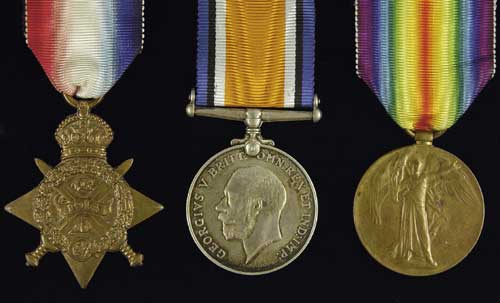
Auction: 7012 - Orders, Decorations, Medals & Militaria
Lot: 766
The Rare and Interesting 1914 Star Trio to Squadron Commander I.H.W.S. Dalrymple-Clark, Royal Naval Air Service, One of Wing Commander Samson´s ´Naval Air Force and Armoured Car Squadron´, Which Proceeded to Ostend, 1914, Attached to the Royal Marine Brigade; Later Accompanied Samson´s Squadron to Dunkirk, Operating Under French Control in the Lille and Cambrai Sector, Where the Little Force Carried Out Reconnaissances by Air, and Raids by Armoured Cars, Which Became an Unexpected Thorn in the German Side; On 3rd September 1914, Dalrymple-Clark Made the First British Bombing Raid of the Great War, and Probably The First of All Time, When He Dropped a 16-Pound Bomb on a Number of Totally Amazed and Demoralised Germans Near Douai; After a Further Number of Typically Hairy Exploits Under Samson He Was Tragically Killed in a Flying Accident, 1916 1914 Star (Sqn. Commdr. I.H.W.S.D. Clark, R.N.A.S.); British War and Victory Medals (Sq. Commr. I.H.W.S. Dalrymple-Clark. R.N.A.S.), good very fine (3) Estimate £ 800-1,000 Squadron Commander Ian Hugh Waldegrave Stair Dalrymple-Clark, educated at Harrow; commissioned as Second Lieutenant, 17th Lancers, and relinquished his position, 1910; he joined the Royal Flying Corps, Naval Wing, as a Probationary Officer, 1913, and was under instruction at the Central Flying School, Upavon, October of the same year; Sub-Lieutenant 17.12.1913; he joined the staff of the Naval Flying School, Eastchurch as Flying Officer, July 1914; Flight Lieutenant, Royal Naval Air Service, and continued at the same station; the Officer Commanding the Eastchurch Squadron (Wing Commander Samson) received orders that his squadron was to proceed in conjunction with a Brigade of Royal Marines to Ostend on the 27th August 1914; the Royal Marines were already in place, with the squadron including Dalrymple-Clarke flying over in their own selected ´veteran´ machines, all with Union Jacks attached to the struts; Samson lead the way and landed on the Leopold Racecourse, Ostend. Upon attempting to land, the squadron were shot at by the Marines who were convinced that they were Germans; luckily no casualties ensued. After establishing an aerodrome on the north side of the harbour, their work consisted of reconnaissance flights over the area between Bruges, Ghent and Ypres.´(Fights and Flights, C.R. Samson, refers); the Marines time in the area was short lived, as they were poorly equipped, and as such were ordered to return to England on the 30th August. After much pleading on Samson´s behalf, his squadron were put at the disposal of the French Army, and were to fly out of Dunkirk. This they did around the Lille and Cambrai area, ´On September 3rd Dalrymple-Clark made our first bomb attack [this was this first British bombing raid of the War]. He was on a reconnaissance to Douai and fortunately carried bombs. Close to Douai he saw about forty Germans near the wood; coming down fairly low, he let go a 16 lb at them. This he saw caused two or three casualties´ (Fights and Flights, C.R. Samson, refers). The Squadron also somewhat accidentally added another string to their offensive capabilities, by armouring their motor transport, to create ´armoured´ cars. ´So this little naval force began at once to operate from Dunkirk, carrying out reconnaissance by aeroplane, and using the motor-cars for raids on the flank of the German communications.´ (Naval Air Service in 1914, refers). This unexpected thorn in the German side, gave Samson´s little squadron almost cult status amongst the local people and proved very popular with the French, especially General Bidon. ´Operations´ included 4.9.1914, when Samson ambushed a car full of six German officers on the Cassel-Bailleul road, injuring two of them. Samson´s Armoured Cars also acted as an escort for a French force on the 6th September, with four motor cars and, ´an aeroplane, flown by Flight Lieutenant Dalrymple-Clark´ (Naval Air Service in 1914, refers). After his exploits on the continent, Dalrymple-Clark returned to England as a Flying Instructor with the rank of Acting Flight Commander at the Central Flying School, January 1915; Flight Commander 23.2.1915; Squadron Commander Central Flying School, April-October 1915; posted as an Instructor to Cranwell Central Depot and Training Establishment, July 1916; it was whilst stationed at Cranwell that he died in a flying accident, ´The sad accident on Friday, September 8th, deprived Cranwell of one of its most energetic and capable officers. Squadron Commander I.H.W.S. Dalrymple-Clark was universally acknowledged to be one of the best pilots in the R.N.A.S., and his loss will be deeply felt throughout the whole Service. Skilful and experienced, he will always be remembered as a most steady and careful pilot, who never essayed foolhardy tricks, all his exhibitions being carried out at safe altitudes.... the accident was one which might happen to any two machines at any time when clouds are about, and consequently no blame can possibly be attached to either pilot, nor can any suspicion of carelessness be hinted at.´ (the Piloteer refers). He is buried in St. Andrew´s Church Yard, Cranwell.
Sold for
£1,900




